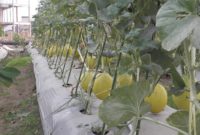This is a common methods of irrigation of wetland rice where water may be applied as a continuous flood, rotational flood or an intermittent flood. This is a suitable method for an area where cheap and abundant supply of water is available. Flooding consists of opening a water channel in a plot of field, so that water can flow freely in all directions and cover surface of the land in a continuous sheet.

Advantages/Pros of Free Flood Irrigation Method:
- No other field layout become necessary except the levelling and preparation of impervious boundary bunds.
- No land area is utilized for water distribution. As a result, wastage of land becomes minimum
- Labour supervision is required for application of water in the field.
- Labour requirement is minimum.
Disadvantages/Drawbacks/Cons of Free Flood Irrigation:
- It is the most inefficient methods of irrigation as only about 20 per cent of water is actually used by plants and the rest is being lost as run off, seepage and evaporation
- Levelling of land increases cost of cultivation.
- This method is unsuitable for crops that are sensitive to water logging.
- Crop growth is not uniform as the water distribution by this method is very uneven.
- There is a possibility of soil erosion.
